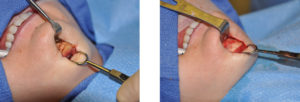The chin represents one of the five main prominences of the face, also including the nose, brow ridges/forehead, cheeks, and jaw angle. It is the defining feature of the lower face. Augmentation or enhancement of a recessed or weak chin is a common plastic surgery procedure that is made fairly simple through the placement of a synthetic implant. Correction of a large or too prominent of a chin, however, is not only less commonly done but is more difficult to do successfully.
A prominent chin has both excess hard and soft tissue. This means that the bone not only has to be reduced but the muscle and skin must be shortened and tightened as well. If the soft tissue of the chin is not properly addressed in a reduction, it will sag off of the reduced bone after surgery resulting in what is known as a ‘witch’s chin’ deformity.

This approach works well for a horizontal chin excess. A vertical chin excess or a long chin, however, requires an intraoral approach with an interpositional wedge osteotomy for its correction. This is a completely different operation with removal and repositioning of bone rather than a simple burring down technique.
Dr. Barry Eppley
Indianapolis, Indiana


